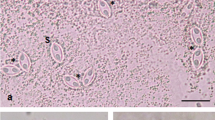Abstract
Myxidium trachinorum sp. nov. is described from the gallbladder of the lesser weever fish Echiichthys vipera. Pseudoplasmodia attach themselves to the gallbladder epithelium by filose processes, which are inserted between host cells. Pseudoplasmodia undergo endogenous cell formation at the secondary and tertiary levels. In the proliferative cycle, primary and endogenous cells are packed with digestive vacuoles formed by phagocytosis. In the sporogonic cycle the pseudoplasmodium becomes a pericyte enclosing two secondary cells (lacking digestive vacuoles) in a vacuole. These give rise to five cells each – two valvogenic, two capsulogenic and a binucleate sporoplasm, which mature into spores. Comparison of the disporic M. trachinorum with polysporic species of Myxidium revealed significant differences in plasmodial ultrastructure, especially their attachments to host cells, surface characteristics and mode of nutrition, and in formation of generative cells. These suggest that the genus Myxidium may require revision.
Similar content being viewed by others
Author information
Authors and Affiliations
Additional information
Received: 18 April 1999 / Accepted: 31 May 1999
Rights and permissions
About this article
Cite this article
Canning, E., Curry, A., Anderson, C. et al. Ultrastructure of Myxidium trachinorum sp. nov. from the gallbladder of the lesser weever fish Echiichthys vipera . Parasitol Res 85, 910–919 (1999). https://doi.org/10.1007/s004360050657
Issue Date:
DOI: https://doi.org/10.1007/s004360050657




